Chess: Understanding the English Opening (Symmetrical Variation) Part IV
1 c4 c5 2 Nf3 Nf6 3 Nc3 d5 4 cxd5 Nxd5 5 e4 Nb4
Line

What's the game plan for White?
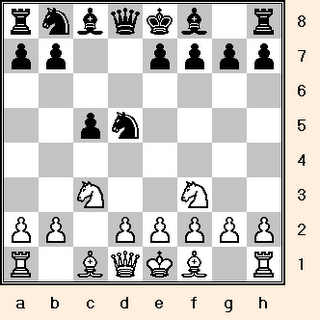
(i) Promptly displace the centralized d5 knight
through e2-e4.
(ii) Eliminate the threat of ... Nd3+ via Bb5+,
d2-d4, a2-a3 and axb4.
What's the game plan for Black?

(i) Play ... Nb4 to threaten ... Nd3+.
(ii) Respond to White's d2-d4 strike with
... cxd4, followed by ... dxc3 and ... c2.
Sample Variation Below
Also available:
Understanding the English Opening
(1 c4 e5 Line)
http://chesscoach1950.blogspot.com/2006/01/chess-understanding-english-opening.html
Chess: Understanding the English Opening
(Symmetrical Variation) Part I
http://chesscoach1950.blogspot.com/2006/07/chess-understanding-english-opening.html
Chess: Understanding the English Opening
(Symmetrical Variation) Part II
http://chesscoach1950.blogspot.com/2006/07/chess-understanding-englis_115360840095778197.html
Chess: Understanding the English Opening
(Symmetrical Variation) Part III
http://chesscoach1950.blogspot.com/2006/07/chess-understanding-english-opening_22.html
Sample Variation
For explanations of moves 1 through 4
please refer to: Understanding
the English Opening (Symmetrical
Variation) Part I
1 c4 c5

2 Nf3 Nf6

3 Nc3 d5
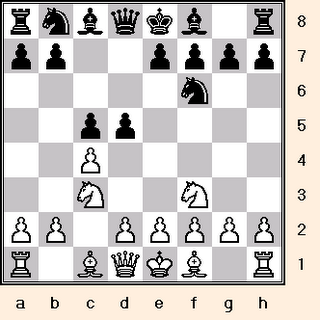
4 cxd5 Nxd5

5 e4

Promptly displacing the knight from its central
location.
5 g3
5 ... Nb4

Threatening the smothery 6 ... Nd3+ 7 Bxd3 Qxd3.
5 ... Nc7? 6 d4 cxd4 7 Qxd4 Qxd4 8 Nxd4 e5 9 Ndb5
9 ... Nxb5 10 Bxb5+ Bd7 11 O-O.
5 ... Nxc3
Understanding the English Opening
(Symmetrical Variation) Part III
6 Bb5+
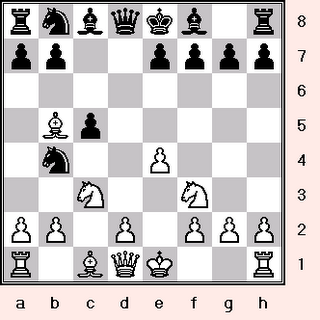
Developing the bishop with check in order to detract
Black from 6 ... Nd3+.
6 Bc4 Nd3+ 7 Ke2 Nf4+ 8 Kf1 Ne6 9 b4 cxb4 10 Nd5 g6
11 Bb2 Bg7 12 Bxg7 Nxg7 13 Nxb4 O-O 14 d4 Bg4 15 Qd2
15 ... Bxf3 16 gxf3 Nc6 17 Nxc6 bxc6 18 f4.
6 Bc4 Nd3+ 7 Ke2 Nxc1+ 8 Rxc1 Nc6 9 Bb5 Bg4 10 h3
10 ... Bd7 11 Re1.
6 d4 transposes to the main line after 6 ... cxd4 7 Bb5+
8 ... N8c6 8 a3.
6 ... N8c6
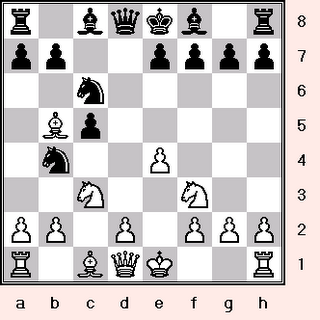
6 ... Bd7!? 7 a3 Bxb5 8 axb4 Bd3 9 Qa4+ Nc6
10 b5 Nb4 11 b6+ Qd7 12 Qxd7+ Kxd7 13 Rxa7.
6 ... N4c6 7 d4 cxd4 8 Qxd4 Qxd4 9 Nxd4 Bd7
10 Nb3 e6 11 O-O Bb4 12 Rd1.
7 d4

(i) Shielding d3 from Black's Queen and consequently
eliminating the threat of 7 ... Nd3+.
(ii) Menacing to attack the pinned c6 knight via d4-d5.
7 ... cxd4
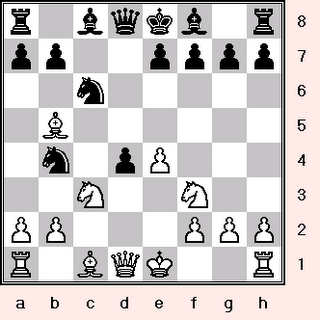
All other options are futile.
8 a3
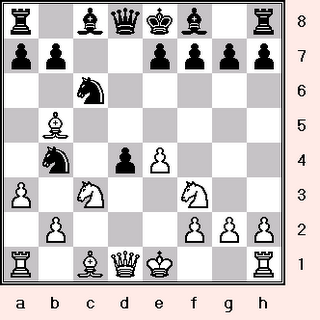
Not 8 Nxd4?? Qxd4 9 Qxd4 Nc2+, and Black is A-OK.
8 ... dxc3
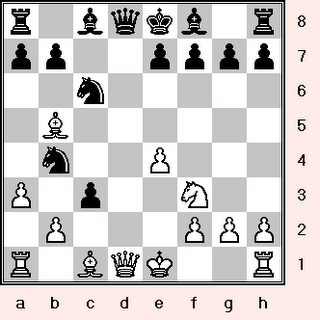
8 ... Bd7 9 Nxd4 Nxd4 10 Bxd7+ Qxd7 11 axb4 e6
12 Be3 Rd8 13 O-O Bxb4 14 Bxd4 Qxd4 15 Qa4+.
8 ... Bd7 9 axb4 dxc3 10 bxc3 g6 11 O-O Bg7 12 Qb3.
8 ... Qb6 9 Bxc6+ bxc6 10 axb4 dxc3 11 bxc3.
9 Qxd8+ Kxd8
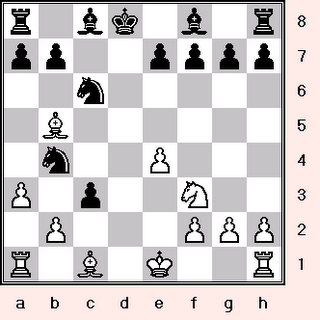
10 axb4 c2
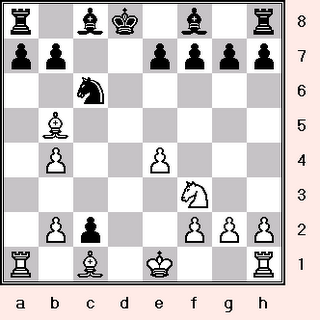
So that White remains with double pawns on b2 and b4.
11 Bxc6 bxc6
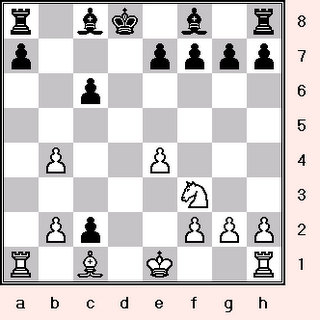
Eliminating the threat of ... Nxb4 and compromising
Black's pawn structure.
12 Ne5 Ke8
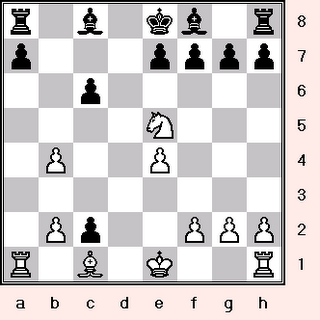
13 Nxf7+ was in the works.
13 Kd2 e6
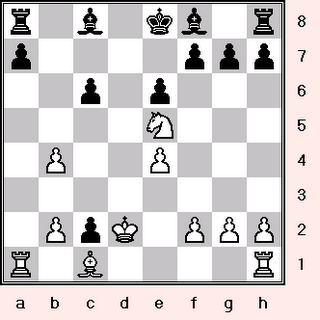
As White goes for the c2 pawn, Black takes aim at the
one on b4.
14 Kxc2

By ChessCoach@care2.com
Line

What's the game plan for White?

(i) Promptly displace the centralized d5 knight
through e2-e4.
(ii) Eliminate the threat of ... Nd3+ via Bb5+,
d2-d4, a2-a3 and axb4.
What's the game plan for Black?

(i) Play ... Nb4 to threaten ... Nd3+.
(ii) Respond to White's d2-d4 strike with
... cxd4, followed by ... dxc3 and ... c2.
Sample Variation Below
Also available:
Understanding the English Opening
(1 c4 e5 Line)
http://chesscoach1950.blogspot.com/2006/01/chess-understanding-english-opening.html
Chess: Understanding the English Opening
(Symmetrical Variation) Part I
http://chesscoach1950.blogspot.com/2006/07/chess-understanding-english-opening.html
Chess: Understanding the English Opening
(Symmetrical Variation) Part II
http://chesscoach1950.blogspot.com/2006/07/chess-understanding-englis_115360840095778197.html
Chess: Understanding the English Opening
(Symmetrical Variation) Part III
http://chesscoach1950.blogspot.com/2006/07/chess-understanding-english-opening_22.html
Sample Variation
For explanations of moves 1 through 4
please refer to: Understanding
the English Opening (Symmetrical
Variation) Part I
1 c4 c5

2 Nf3 Nf6

3 Nc3 d5

4 cxd5 Nxd5

5 e4

Promptly displacing the knight from its central
location.
5 g3
5 ... Nb4

Threatening the smothery 6 ... Nd3+ 7 Bxd3 Qxd3.
5 ... Nc7? 6 d4 cxd4 7 Qxd4 Qxd4 8 Nxd4 e5 9 Ndb5
9 ... Nxb5 10 Bxb5+ Bd7 11 O-O.
5 ... Nxc3
Understanding the English Opening
(Symmetrical Variation) Part III
6 Bb5+

Developing the bishop with check in order to detract
Black from 6 ... Nd3+.
6 Bc4 Nd3+ 7 Ke2 Nf4+ 8 Kf1 Ne6 9 b4 cxb4 10 Nd5 g6
11 Bb2 Bg7 12 Bxg7 Nxg7 13 Nxb4 O-O 14 d4 Bg4 15 Qd2
15 ... Bxf3 16 gxf3 Nc6 17 Nxc6 bxc6 18 f4.
6 Bc4 Nd3+ 7 Ke2 Nxc1+ 8 Rxc1 Nc6 9 Bb5 Bg4 10 h3
10 ... Bd7 11 Re1.
6 d4 transposes to the main line after 6 ... cxd4 7 Bb5+
8 ... N8c6 8 a3.
6 ... N8c6

6 ... Bd7!? 7 a3 Bxb5 8 axb4 Bd3 9 Qa4+ Nc6
10 b5 Nb4 11 b6+ Qd7 12 Qxd7+ Kxd7 13 Rxa7.
6 ... N4c6 7 d4 cxd4 8 Qxd4 Qxd4 9 Nxd4 Bd7
10 Nb3 e6 11 O-O Bb4 12 Rd1.
7 d4

(i) Shielding d3 from Black's Queen and consequently
eliminating the threat of 7 ... Nd3+.
(ii) Menacing to attack the pinned c6 knight via d4-d5.
7 ... cxd4

All other options are futile.
8 a3

Not 8 Nxd4?? Qxd4 9 Qxd4 Nc2+, and Black is A-OK.
8 ... dxc3

8 ... Bd7 9 Nxd4 Nxd4 10 Bxd7+ Qxd7 11 axb4 e6
12 Be3 Rd8 13 O-O Bxb4 14 Bxd4 Qxd4 15 Qa4+.
8 ... Bd7 9 axb4 dxc3 10 bxc3 g6 11 O-O Bg7 12 Qb3.
8 ... Qb6 9 Bxc6+ bxc6 10 axb4 dxc3 11 bxc3.
9 Qxd8+ Kxd8

10 axb4 c2

So that White remains with double pawns on b2 and b4.
11 Bxc6 bxc6

Eliminating the threat of ... Nxb4 and compromising
Black's pawn structure.
12 Ne5 Ke8

13 Nxf7+ was in the works.
13 Kd2 e6

As White goes for the c2 pawn, Black takes aim at the
one on b4.
14 Kxc2

By ChessCoach@care2.com

0 Comments:
Post a Comment
<< Home